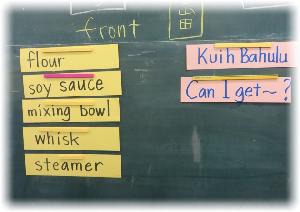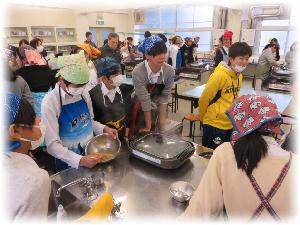1月16日 133号 英語でクッキング ~研究授業 英語~
 「アクティブラーニング 調理実習」
「アクティブラーニング 調理実習」
千里 九「Kuih Bahulu(クイバフル)は、マレーシアの伝統的なお菓子である。食べてみたい」
|
|
|
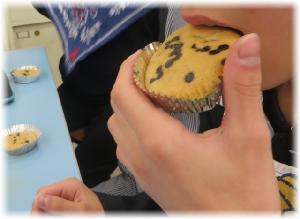 |
|
調理材料(写真1) |
英語で調理中(写真2) |
英語で試食中 (写真3) |
先週13日の金曜日草木も起きている6限目に2-5組が残され、いや選ばれ他のクラスはさようならをしました。他クラスが完全下校した後で英語の研究授業を、上垣内先生が”調理室”でおこなったのです。何故?調理室と思いつつも多くの先生方が調理室へ足を運びました。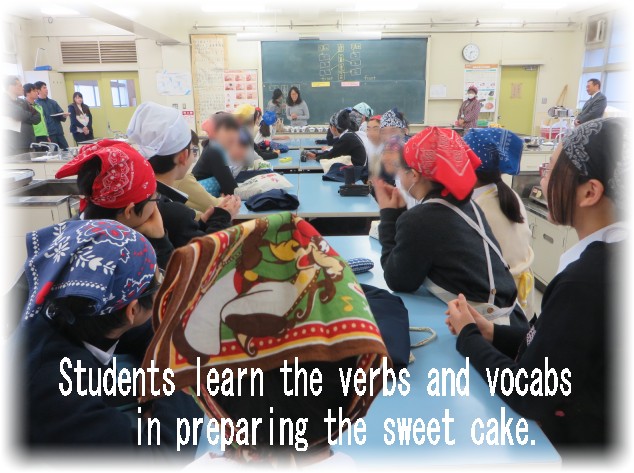
未(ひつじ)の刻 そこは調理室だった。当然ふだんは家庭科の授業がおこなわれる。その家庭科の牙城に英語科が突撃したのには理由がある。現代は午前の12時間と午後の12時間を24時間で一日としているのが常識だ。だが明治までは丑の刻とか寅の刻など十二支で時を表していた。研究授業がおこなわれる午後2時は、未(ひつじ)の刻、”八つ”時と呼ぶ。だからこの時間帯に食べるのを「お八つ」というようになったのである。学校では勝手におやつを食べていけないが、授業の中では別腹なのだ。英語を使って調理室で調理し食べていい。担当者の狙いはここにあった。
英語でクッキング 教科担当者は考えた。これまで学習し身につけた内容を”知識”から実際に与えられた状況や場面の中で、「使える英語」にしたい。今回の活動で調理する「Kuih Bahulu(クイバフル)」は、本校のAET: Chong先生の出身国マレーシアの伝統的なお菓子(スイーツ)だ。食べたければ英語を理解し話す必要に迫られる。きっと調理室で調理する”過程”では英語をしゃべる場面が多くなるだろう。お年頃の中学生はお腹が減るから。家庭科助手の先生もいつもと違う準備が必要である。調理に関する英単語を腕に書く(右写真)。生徒にはチラ見で伝えた。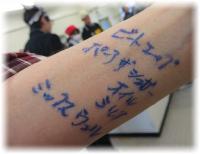
Cooking Time(写真1,2,3) Teacher : Student number 1, please come forward to take the egg and the whisk. Student 1 : Can I get the egg and the whisk, please? Teacher : Student number 2, please come forward to get the brown sugar. Student 2 : Can I get the brown sugar, please? Teacher : Student 3, please come and get your cooking oil and soy sauce. Student 3 : Can I get the cooking oil and soy sauce, please? Teacher :Student 4, please come forward to get your milk. Student 4 : Can I get some milk ,please? Teacher : Student 5, please come forward to get your flour please. Student 5 : Can I get the flour? Teacher : Winner group, please choose a topping for your Kuih Bahulu. Group leader : Can I get the chocolate topping, please?
Review Time Teacher : What is the name of the sweet cake we made today? Student : Kuih Bahulu. Teacher : Do you like the taste? Student : Yes, it is delicious.
英語科担当者 「日ごろ学んでいる英語を実践的に『使える』英語にしていきたい。英語を学ぶのではなく英語で学ぶ機会になればと”英語でCooking!”に挑戦してみました。」
関わりの中で子どもが伸びた場面 Yes, it is delicious.




